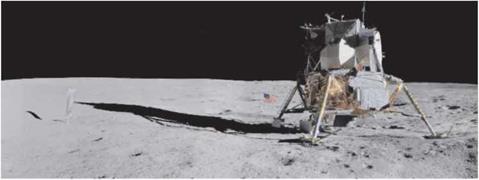TRY AGAIN: APOLLO 14
With Apollo 13, NASA had dodged a bullet. The flight had very nearly killed its crew and, as always happens when it is hit by traumatic events, NASA needed a hiatus to investigate and understand what had disrupted Odyssey’s service module. Although there were calls from both inside and outside the administration to end Apollo before anyone else got killed, its managers kept faith with it. The programme of exploration which they instituted, now almost forgotten, visited immensely beautiful sites with spectacular vistas. Hnhaneed equipment allowed crews to explore further from the LM, and although the results from these missions had little political impact, their scientific findings now underpin our understanding of the early history of the solar system.
Apollo 14 returned the programme to the Moon to achieve what its predecessor had set out to do: visit the Fra Mauro area to gain insight into the formation of the Imbrium Basin. The precise target for the lunar module Am ares was near a relatively fresh impact feature dubbed Cone Crater. The scientists’ interest in Cone arose from a useful property of crater formation whereby, w’hen an impactor hits the ground, it removes the target rock in such a way that the most deeply excavated material ends up at the rim of the crater and material from successively shallower depths is deposited at increasing distances in an ejecta blanket. By having the surface crew of Alan Shepard and Edgar Mitchell radially sample this blanket as they walked towards its rim, geologists hoped to use Cone Crater as a convenient 25-million-year – old ‘drill hole’ to sample down through the ejecta blanket of the Imbrium Basin impact itself, which is now thought to have occurred 3.91 billion years ago.
The launch from Earth on 31 January 1971 was successful, and once they were on course for the Moon command module pilot Stu Roosa separated CSM Kitty Hawk from the S-IVB, turned around and attempted to dock with the LM Ant ares. For reasons that have never been clear, the docking was unsuccessful, and five further attempts were required to capture the lander. At the Moon, just before Antares was due to begin its powered descent to the surface, an intermittent short circuit threatened to abort the mission as soon as its engine ignited. A virtuoso engineering effort between mission control and the crew1 reprogrammed the computer, instruction by instruction, to work around the problem.
Being the last of the H-missions, the surface crew were scheduled two excursions
|
Apollo 14’s LM Airfares and the landing site at Fra Mauro. (NASA) |
outside. On their first day, Shepard and Mitchell set up a second ALSEP science station and explored their locale. On their second day they were to undertake a trek of over a kilometre across the hummocky plain and up a shallow ridge to approach the 370-metre-diameter Cone Crater. The climb proved to be tiring and, as they neared the summit, they experienced difficulty in locating the crater. They had come 400,000 kilometres to get to this rim but were reaching the safe limits of their oxygen supply. With time running out, they collected a clutch of samples and turned back. Analysis later showed that they had navigated to within 30 metres of the rim, which was near enough for their samples to represent material from deep within the Imbrium ejecta.
Back at the LM, Shepard pulled off a famous stunt by attaching a genuine golf club head to the shaft of one of his tools and hitting golf balls he had smuggled to the Moon. Meanwhile, in lunar orbit, Roosa had planned an aggressive campaign of orbital photography with a high-resolution mapping camera attached to the hatch window. When the instrument failed early on, he was able to accomplish some of his photographic assignments by clever flying and using handheld cameras.
Apollo 14 was a highly successful mission that restored NASA’s confidence and prepared it for the triumphs of exploration and science to come. It was also the last time lunar explorers were required to undergo a period of biological isolation after landing on Earth. The returned rocks allowed geologists to probe the nature of the ejecta from the formation of the Imbrium Basin. They could apply the principle of superposition, whereby one feature can be seen to overlie another, to distinguish between pre-Imbrium and post-Imbrium landforms.











